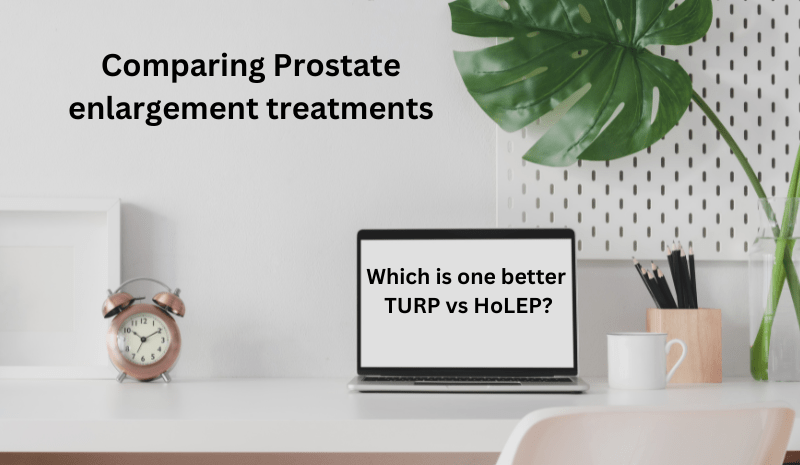Nothing is more frustrating than slow-moving traffic, snail-speed Wi-Fi connection, and poor peeing flow.
And even more when the urine urge is frequent. Stress is a popular culprit for most life problems but what if it is your enlarged prostate gland that is the cause for all your urinary problems?
Yes, the gland which is located at the base of the bladder and contributes for a major part of the semen. Prostate starts enlarging naturally after the age of 50 years.
So, then why does it become problematic?
Being so closely situated in the pelvic area, when the prostate enlarges, it squeezes the urinary tube called the urethra (carries urine out of the body) through the penis. Hence, frequent peeing, poor urine stream, urine infection, or difficulty emptying the bladder etc. which are the signs of prostate enlargement.
Thus, to address such troubles of peeing because of an enlarged prostate, the two most commonly performed surgeries are done to treat prostate enlargement i.e. Transurethral resection of the prostate (TURP) and Holmium laser enucleation of the prostate (HoLEP). Both procedures effectively relieve symptoms and improve quality of life, but they have different advantages and disadvantages.
In this blog post, we will compare TURP and HoLEP concerning safety, efficacy, recovery time, and potential complications. We will also discuss the factors to consider when choosing between the two procedures.
In TURP surgery, the doctor inserts a thin tool with a light and a camera into the urethra. This is the tube that carries urine out of the body. The tool has a wire loop that cuts away the extra prostate tissue with an electric current.
The tissue is flushed out with fluid and collected for analysis. TURP is the most commonly performed surgery for an enlarged prostate. This helps in improving urine flow and reducing symptoms.
During the HOLEP surgery, the doctor also inserts a tool with a light and a camera into the urethra, but instead of a wire loop, the tool has a laser. The laser is used to cut the extra prostate tissue into small pieces that are pushed into the bladder. Then, the doctor uses another tool to suck out the tissue from the bladder. HOLEP is a newer surgery that has some advantages over TURP. And they include less bleeding, shorter hospital stays, and lower risk of complications. Furthermore, it can be done without stopping the blood thinners used for cardiac problems.
Safety:
TURP was considered the gold standard treatment of benign prostatic hyperplasisa (BPH) (i.e. prostate enlargement) in the past decades. Both TURP and HoLEP are generally safe procedures. But as with any surgery, there are some potential risks associated with each surgery.
Other common risks such as bleeding, urinary tract infections and retrograde ejaculation are associated with both surgeries.
Risks from TURP surgery:
- Bleeding: TURP can cause significant bleeding during surgery. In some cases, a blood transfusion may be necessary.
- TUR syndrome: TUR syndrome is a rare but serious complication of TURP. It occurs when the irrigation fluid containing glycine used during surgery is absorbed into the bloodstream and causes an imbalance in electrolytes.
- Urinary tract infections: Urinary tract infections are a common complication of both TURP and HoLEP.
- Retrograde ejaculation: Retrograde ejaculation is a condition in which semen flows back into the bladder during orgasm. It is a common complication of both TURP and HoLEP.
Risks from HoLEP surgery:
HoLEP was associated with a significantly lower risk of urethral stricture. Others include – - Bleeding: HoLEP is associated with less bleeding than TURP. However, bleeding can still occur, and in some cases, a blood transfusion may be necessary.
- Hyponatremia: TUR syndrome is very rare with HoLEP compared to conventional TURP.
Efficacy:
TURP provides good outcomes in terms of improving urinary flow, reducing symptoms, and enhancing quality of life.
However, research showed that HoLEP offered safer outcomes with less bleeding and potentially better long-term relief of urinary bladder outlet obstruction. TURP is largely recomended in patients with small to mid-sized prostates. HoLEP is particularly advantageous in treating larger prostates, offering a minimally invasive alternative with many advantageous and durable results. Both TURP and HoLEP are effective in relieving symptoms of prostate enlargement and improving quality of life.
Recovery time:
The recovery time for TURP is typically longer than the recovery time for HoLEP. Patients who undergo TURP usually need to stay in the hospital for 1-2 days and to wear a catheter for 5-7 days. And those who opt for HoLEP usually only need to stay in the hospital for 1-2 days and wear a catheter for 1-2 days.
Recovery time after HoLEP is similar to TURP, with the added benefit of reduced bleeding post-operation.
For both surgeries, most can resume normal activities within a few weeks. However, complete recovery may take several weeks. But, the precise nature of the laser surgery contributes to a quicker recovery for many patients.
Potential complications
In addition to the risks listed above, there are some other potential complications associated with TURP and HoLEP such as bladder neck contracture, urine leakage (urinary incontinence), impotency (erectile dysfunction) etc. Several research papers have also found urethral stricture to be one of the many long-term complications. Conclusion:
Both TURP and HoLEP are effective surgical treatments for BPH, each with its safety profile, efficacy, and potential complications.
The choice between them is often based on factors such as prostate size, patient preference, and surgeon expertise.
It is crucial to consult with an expert urologist to determine the most appropriate treatment plan for your specific case.

